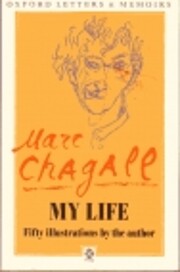

Click on a thumbnail to go to Google Books.
|
Loading... My Life (1923)by Marc Chagall
 None No current Talk conversations about this book. Chagall's writing is very reminiscent of his painting: the feelings of a child-genius. 'Here is my soul. Look for me here; here I am, here are my pictures, my roots' Marc Chagall, one of the twentieth century's most popular artists, grew up in a close-knit, bustling Russian-Jewish community, the son of a herring seller. In his colourful, dreamlike autobiography, written as he was about to leave his homeland for good in 1922, he vividly brings to life the memories and places that fed into his unique work, from his shtetl childhood to revolutionary Russia and Belle Èpoque Paris. Filled with Chagall's own evocative illustrations, My Life is as warm, joyful and humane as his art no reviews | add a review
Marc Chagall's strange, vibrant, and poetic autobiographical essay on his early life, containing illustrations, has established itself as a unique document in 20th-century literature Completed by the artist in 1922, this memoir became available in English in 1965 when Peter Owen published this translation, and it has remained in print ever since. Lyrical and evocative, it is a key work in Chagall studies for the light it sheds on the shaping of the artist's creative genius. His deep roots in Jewish tradition--religious and secular--are reflected in these recollections of his poverty-stricken youth from Witebsk, White Russia, to the Parisian art world. Together, his words and pictures paint an incomparable portrait of one of the greatest artists of this century, and of the now vanished milieu that inspired him. No library descriptions found. |
Current DiscussionsNonePopular covers
 Google Books — Loading... Google Books — Loading...GenresMelvil Decimal System (DDC)759.7The arts Painting History, geographic treatment, biography Russia and eastern EuropeLC ClassificationRatingAverage: (3.41) (3.41)
Is this you?Become a LibraryThing Author. |
||||||||||||||||||||||||||||||||||||||||||||||||||||||||||||||||||||||||||||||||||||||||||||||||||||||||||||||||||||||||||
This autobiography was written by Marc Chagall while he was in Moscow in 1922 when he was in his mid-thirties. It covers his early years in Vitebsk in Belarus in what was then the Russian Empire, his time as a young artist in St Petersburg and Paris, and his return to revolutionary Russia as a mature artist and teacher. Chagall was a secular Jew but his origins in Russian-Jewish folk culture and his beloved hometown of Vitebsk were important to him. The expressionistic writing style of this autobiography is very reminiscent of his visual artistic style, which is also amply demonstrated through his many illustrations of the text. (